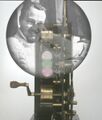Template:Selected anniversaries/January 23: Difference between revisions
No edit summary |
No edit summary |
||
| Line 40: | Line 40: | ||
||1870: In Montana, U.S. cavalrymen kill 173 Native Americans, mostly women and children, in what becomes known as the Marias Massacre. | ||1870: In Montana, U.S. cavalrymen kill 173 Native Americans, mostly women and children, in what becomes known as the Marias Massacre. | ||
||1872: Paul Langevin born ... physicist and academic. | ||1872: Paul Langevin born ... physicist and academic. Pic. | ||
||1876: Otto Diels born ... chemist and academic, Nobel Prize laureate. | ||1876: Otto Diels born ... chemist and academic, Nobel Prize laureate. Pic. | ||
||1888: Paul Peter Ewald born ... physicist and crystallographer whose theory of X-ray interference by crystals was the first detailed, rigorous theoretical explanation of the diffraction effects first observed in 1912 by his fellow physicist Max von Laue. Pic: https://www.todayinsci.com/8/8_22.htm | ||1888: Paul Peter Ewald born ... physicist and crystallographer whose theory of X-ray interference by crystals was the first detailed, rigorous theoretical explanation of the diffraction effects first observed in 1912 by his fellow physicist Max von Laue. Pic: https://www.todayinsci.com/8/8_22.htm | ||
||1891: Abram Samoilovitch Besikovitch born ... mathematician. He will work on combinatorial methods and questions in real analysis, such as the Kakeya needle problem and the Hausdorff-Besicovitch dimension. | ||1891: Abram Samoilovitch Besikovitch born ... mathematician. He will work on combinatorial methods and questions in real analysis, such as the Kakeya needle problem and the Hausdorff-Besicovitch dimension. Pic. | ||
File:Oliver Blackburn Shallenberger.jpg|link=Oliver B. Shallenberger (nonfiction)|1898: Electrical engineer and inventor [[Oliver B. Shallenberger (nonfiction)|Oliver Blackburn Shallenberger]] dies. He invented the first successful alternating current electrical meter, which was critical to the general acceptance of AC power. | File:Oliver Blackburn Shallenberger.jpg|link=Oliver B. Shallenberger (nonfiction)|1898: Electrical engineer and inventor [[Oliver B. Shallenberger (nonfiction)|Oliver Blackburn Shallenberger]] dies. He invented the first successful alternating current electrical meter, which was critical to the general acceptance of AC power. | ||
Revision as of 17:28, 21 December 2018
1656: Blaise Pascal publishes the first of his Lettres provinciales.
1805: Inventor Claude Chappe dies. He invented and developed a practical semaphore system that eventually spanned all of France -- the first practical telecommunications system of the industrial age.
1854: Mathematician Leopold Kronecker discovers new family of Gnomon algorithm functions.
1862: Mathematician David Hilbert born. he will discover and develop a broad range of fundamental ideas in many areas, including invariant theory and the axiomatization of geometry.
1862: Glassblower, physicist, and Gnomon algorithm theorist Johann Geißler demonstrates an advanced version of the Geissler tube which acts as a simple scrying engine, using low pressure gas-discharge luminescence as a remote-input-output modulator.
1898: Electrical engineer and inventor Oliver Blackburn Shallenberger dies. He invented the first successful alternating current electrical meter, which was critical to the general acceptance of AC power.
1941: Charles Lindbergh testifies before the U.S. Congress and recommends that the United States negotiate a neutrality pact with Adolf Hitler.
1967: John Brunner uses scrying engine to detect and expose crimes against mathematical constants.
1974: Mathematician, academic, and crime-fighter Werner Fenchel publishes new class of Gnomon algorithm functions which use nonlinear programming techniques to detect and prevent crimes against mathematical constants.
2003: A very weak signal from Pioneer 10 is detected for the last time; no usable data can be extracted.
2007: CIA officer and author E. Howard Hunt dies. Along with G. Gordon Liddy, Hunt plotted the Watergate burglaries and other undercover operations for the Nixon administration.











